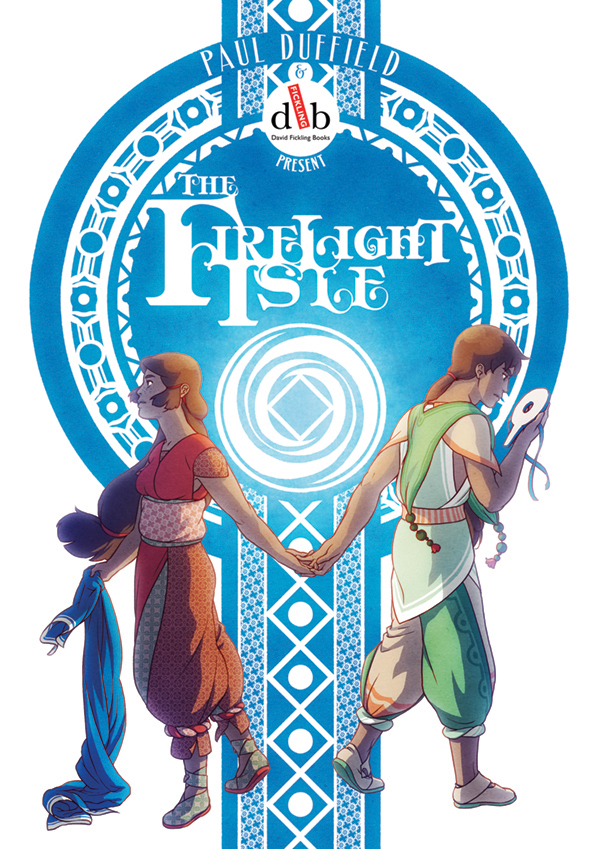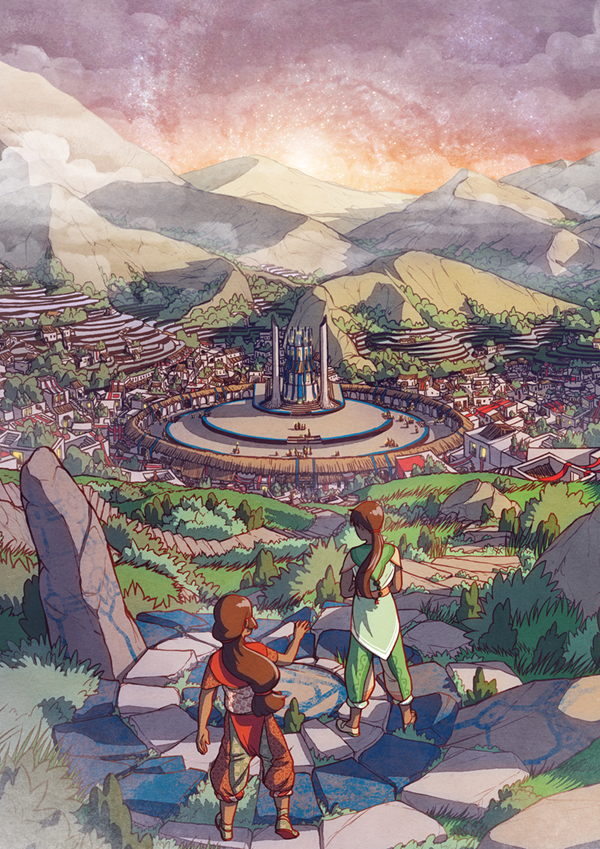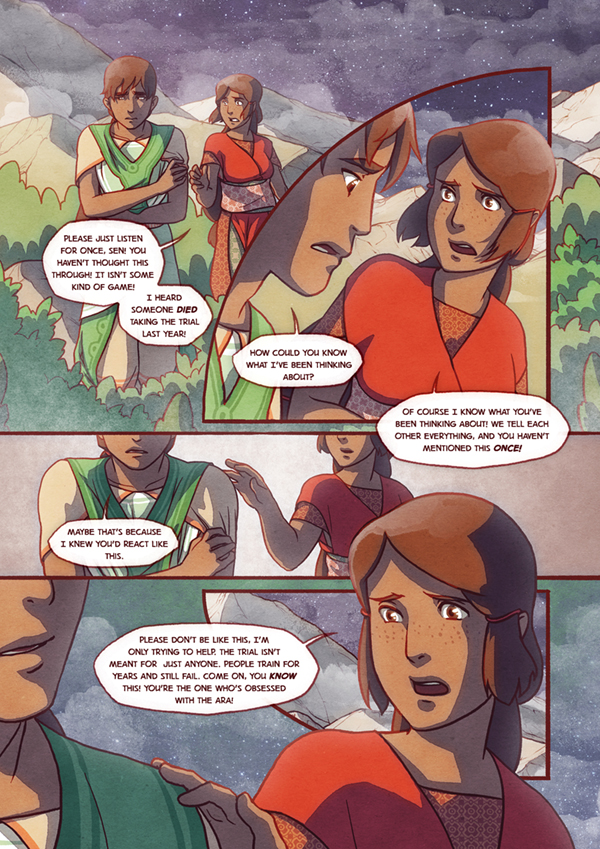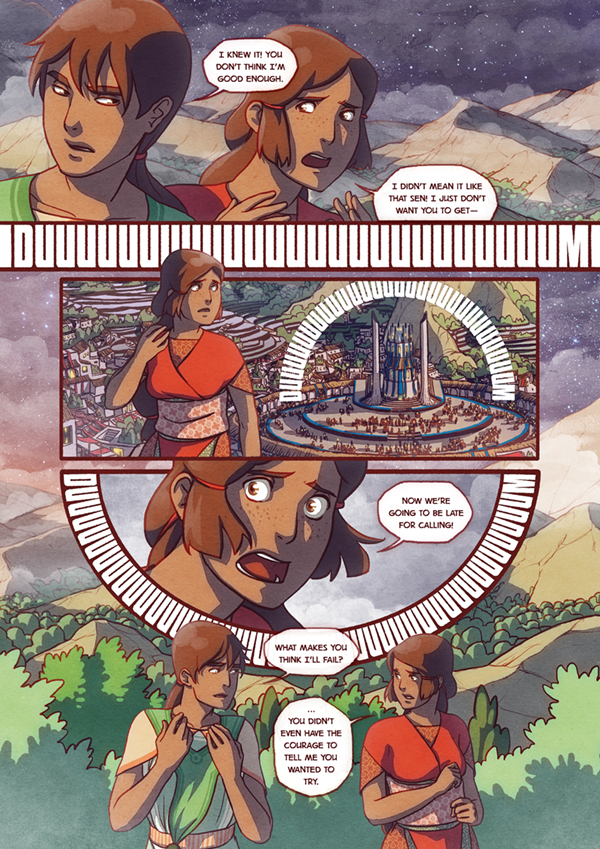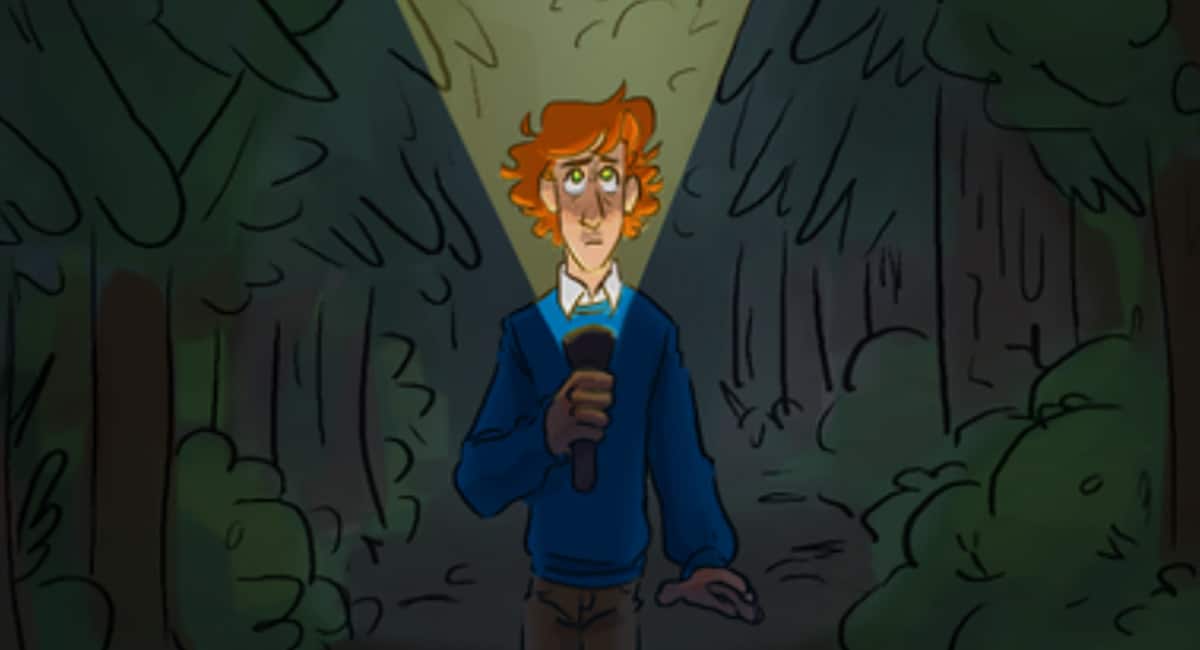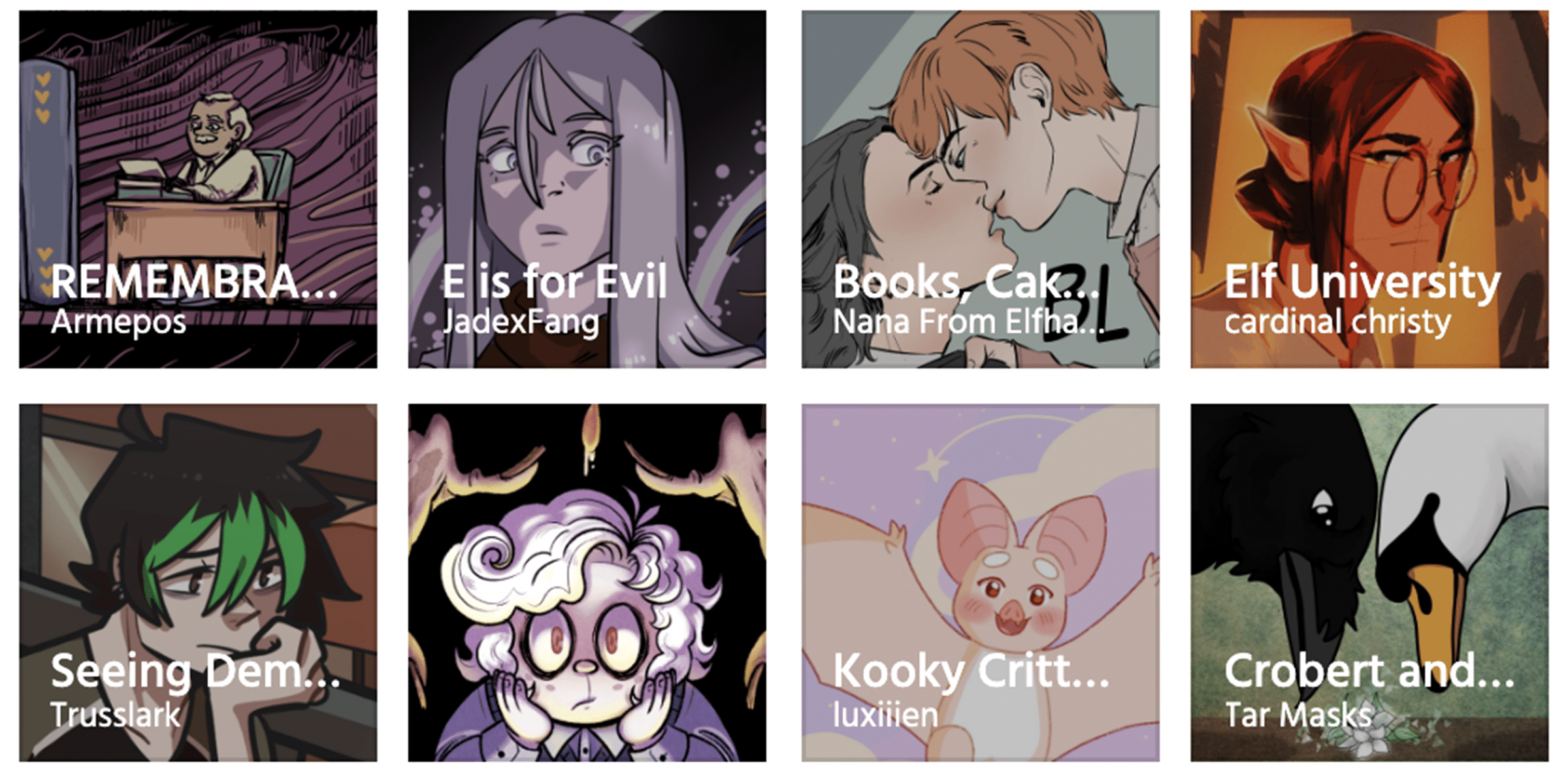Paul Duffield has been working on a huge new project for a long time now, following the finale of his co-created web series Freakangels with Warren Ellis. But today we can exclusively reveal his next big work – The Firelight Isle, a webseries which will debut online and then subsequently be published through David Fickling Books.
A series with a strong element of fantasy and adventure to it, The Firelight Isle will debut online at the end of this month, coinciding with Thought Bubble 2013. He’s been sharing his process online over the last few months, and his pages looked so stunning that I just HAD to talk to him about the project. So I did! Read on to find out all about The Firelight Isle!
Steve: What is The Firelight Isle? What’s the general idea of the story?
Paul: The best way to describe The Firelight Isle is “cultural fantasy” or “fantasy without magic” – I wanted to create a world that could actually exist given the right conditions, but also felt fantastical and dream-like. The story follows Anlil and Sen, two childhood friends who are both coming of age, and going through the trials that will determine their future. They’re determined to remain together despite living lives that are pulling them apart.
The themes I want to work with in the story revolve around are identity, religion and isolation. There’s much more to the story as the plot develops, but I don’t want to give too much away at this point!
Steve: Was this a project you’ve had in mind for a while, or a fresh concept you thought up just prior to starting?
Paul: A bit of both actually! At its heart, this is a re-working of a story that is very very old. However, it’s such an extreme re-work that the only thing remaining from the original is the gender and age of the two main characters, so in that respect the story is all brand new!
Steve: What made you decide to dive into this as your next big project – what about the story did you find most attractive, and resolved you to picking up this world and characters and creating a new work?
Paul: A deep desire to write! I’ve always written my own stories, and writing is just as much a part as what I want to do as drawing is. I’ve had a number of short comics published in various places, but I felt that because my work on Freakangels I was being thought of more as an artist than as a writer. After Freakangels finished, it felt like one of those now-or-never things. Since then I’ve discovered it’s a lot harder to break into writing commercially than it is to draw commercially!
In terms of the story itself, I wanted to write something from the heart, with no pretences – something in the style and genre that I’m most fond of, and something that I would love to read myself, so the whole project is very much my kind of story.
Steve: Once you decided to create this story, how did you start? Did the characters come first, or the world, or the narrative?
Paul: I started by building the culture and world that the story is set in, and then worked on the plot and characters together. However, I discovered quite fast that a culture, no matter how exotic, is rather empty and meaningless without its characters. My editor encouraged me to focus on the characters themselves, and it wasn’t until I understood their temperaments and delved into the situations they go through that the setting finally started coming alive!
Steve: And where did you start when writing/establishing the narrative? Did you work out the skeleton of the story and then work sequences and settings into that bare-bones, model, or do you prefer to work chronologically?
Paul: I didn’t really have a deliberate method, since this is my first serious attempt at long form writing, but I started with small scenes here and there that formed themselves in complete chunks. The ending of the story was actually one of the first of these that I wrote! After that, I constructed a skeleton of the plot, and filled in the remaining scenes more-or-less sequentially. However, that was just step one! In the two years since then, there have been exhaustive re-writes, and many of the original scenes are gone or radically changed.
Steve: Have you found yourself moving away from the scripting at any point, to thumbnail and plan a sequence and see how it’d work on the page? Do you break up the writing and pencilling so they run side-by-side?
Paul: To be honest, I don’t use a script at all! Since I’m doing the art, it seems strange to convert what are essentially visual ideas into writing and then back into images again. For me, the flow of the scene and the meaning of the interaction between the characters is the core of a story, and I find capturing that with a quick sketch much easier than writing it, which leaves the dialogue.
That’s something I work on in two ways – first as a series of impressions and snatches of dialogue, then after I’ve thumbnailed the pages, whilst I’m doing the roughs, I go in and flesh it out. The dialogue also gets another round of editing after I’ve finished the art. The only stage of planning I use text for is making a note of the structure of the plot, and even then I like to colour-code my notation, and arrange it almost in verses.
Steve: You’re not arranging the art in a traditional page-by-page style – you’re planning for the story to work in different ways for print and digital. Can you explain a little how The Firelight Isle is going to work?
Paul: There are two “edits” of the comic – the web edit and the print edit. Whilst I’m doing the art for each page, I compose it as if for print, but extend it quit a bit above and below the area that will be printed (basically, an extra-extra-large veritcal bleed). The web edit is made by merging the pages together, top to bottom, creating a long ribbon that reads with a pacing designed to be scrolled through.
The print edit is made by cropping the printable part of each page and laying them out traditionally, which reads with a slightly different pacing optimised for a book. So despite being taken from the same material, they will both read slightly differently.
Steve: The story will be published by David Fickling Books, an increasingly familiar name for fans of British comics. What made you decide to work with their publishing house?
Paul: I’ve known David Fickling for quite a while now, from the very early days of the DFC (the comic that The Phoenix replaced), and I can say without reservation that DFB is the most honest, open and passionate publisher that I’ve had the privilege of working with. They care deeply about story-telling, and they put the production of good stories above every other aspect of publishing, often taking financial risks to do so. It’s that pioneering urge that underpinned their recent decision to move away from Random House and become an independent publisher with more flexibility and creative freedom.
True to that principle, they embrace story-telling of all kinds, novels, comics, picture-books (David is even an avid gamer), and are working towards a future in which all story-telling media command the same cultural attention. That’s a vision I share wholeheartedly, and I believe that David has the enthusiasm and influence to make it happen! I’m doing everything in my power to help, and my work at The Phoenix along with my work on The Firelight Isle is part of that.
Steve: David is editing the project himself – what has he brought to The Firelight Isle, as editor?
Paul: It’s hard to know where to start! This is my first long-form story, and was still quite undeveloped when I started working with him – now it has been in development for two years, which is a long road for someone used to putting out 6 finished pages a week! The editing experience has been enlightening, challenging and at times frustrating. David doesn’t interfere much with the “who” “where” and “what” of the plot or the characters, but he digs deeply into how the story is told.
He won’t let a sequence rest until it communicates everything it needs to in the most affecting way possible. Some parts are on their 4th or 5th draft, but looking at what I’ve done so far, I wouldn’t have it any other way! I feel privileged that The Firelight Isle is benefiting from his experience and insight, and it’s been an amazing thing to sit alongside the amazing authors like Philip Pullman who he’s worked with in the past.
Steve: On your blog you list the three tools of your creative process: your notebook, your editorial notes, and your laptop. How do you plan a particular page, from sketch to edit to final product?
Paul: I start with the notebook, planning sequences using small sketches or sometimes even doodled stick figures – whatever helps me remember the ideas I’m having. After that, I move to thumbnails (which in my case are sometimes closer to roughs), and a light version of the script. During this process, I’m arranging sequences and plotting the story using a botched kind of shorthand on the laptop. The whole thing comes together in an In Design document that contains the latest draft of the thumbnails, along with provisional lettering.
Steve: You also mention that a large amount of research went into the story, in order to establish a compelling and believable culture for the world you’re creating. How do you approach the research aspect of the creation process?
Paul: The research went mainly into anthropology! Fantasy books are littered with artefacts from the culture of their author in the form of customs, mannerisms, language, ideology, you name it! Quite often, these artefacts come from huge assumptions about the “way that people work” that undermine the story or cause the world to feel flimsy and artificial – like a spaghetti western in which the town is only as deep as the front of the buildings. I felt that in order to build a culture effectively, I first had to dismantle my own cultural assumptions, and discover what parts of my personal experiences are human universals, and which are peculiar to my own culture and place in history.
I started with a fantastic series of lectures on Anthropolgy taught by Rosemary Joyce and worked onto specific text books. I was researching clothing, building, religion, caste, and various other things in order to fill my head with material that I could take inspiration from, and in order to avoid pitfalls that could make the human element of the story flimsy or shallow. It was definitely an enlightening journey, but I often feel like I un-learnt more than I learnt during that time! Weirdly enough, I’m also pretty sure that that’s exactly what I needed to do without knowing it…
Steve: How long-term are your plans with the story, and how long will each issue be?
Paul: Currently the book is projected to be around 300 pages, although the second half is still in an early draft, and that could change. To that end, I’m planning to release the story episodically, and fit the overall length to the demands of the story. I’ve already printed part of the first chapter in the form of a mini-comic for Thought Bubble (the comics arrived from the printers just a few hours ago)!
Steve: Finally – where can we follow the project as you continue onwards?
Paul: I’m currently making the website ready for the launch of the first episode of the webcomic on the weekend of The Thought Bubble Comic Festival (23rd – 24th of Novemeber). In the meantime, you can watch an animated trailer and read through past blog entries about the creation of the project at thefirelightisle.com.
I’ll be tweeting about my progress as @paul_duffield and posting the odd image onto my deviantart account.
@stevewmorris


